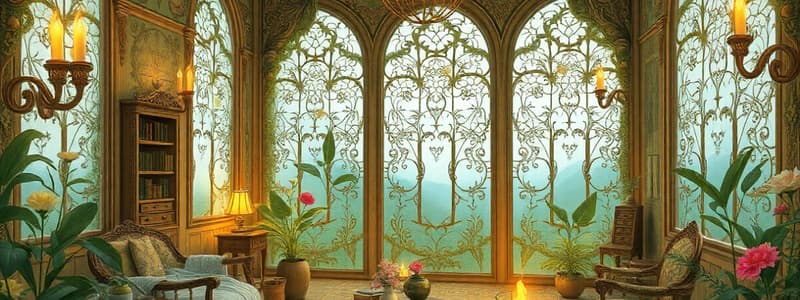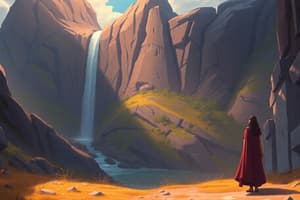Podcast
Questions and Answers
What is a 'backdrop setting' in storytelling?
What is a 'backdrop setting' in storytelling?
- A vague and simple time and location (correct)
- A specific location and time in a story
- A location with detailed historical context
- A setting focused on the weather
Which element is NOT considered part of the five main story elements in literature?
Which element is NOT considered part of the five main story elements in literature?
- Characters
- Resolution
- Conflict
- Theme (correct)
How is 'theme' in literature distinguished from mood?
How is 'theme' in literature distinguished from mood?
- Theme is the specific lesson of the story
- Theme is the general atmosphere conveyed through words
- Theme is the main characters' emotional state
- Theme is the overarching idea consistent throughout the piece (correct)
What narrative tool involves introducing characters, time, and place to the reader?
What narrative tool involves introducing characters, time, and place to the reader?
What type of setting focuses specifically on the geographical location?
What type of setting focuses specifically on the geographical location?
What is the primary difference between the subject and the theme of a story?
What is the primary difference between the subject and the theme of a story?
Which of the following is an example of a major theme?
Which of the following is an example of a major theme?
Imagery in a story is primarily used for what purpose?
Imagery in a story is primarily used for what purpose?
How does diction contribute to a writer's style in fiction?
How does diction contribute to a writer's style in fiction?
What aspect of setting can include societal and cultural surroundings?
What aspect of setting can include societal and cultural surroundings?
Which of the following is an example of imagery used in fiction writing?
Which of the following is an example of imagery used in fiction writing?
Why do writers of modern fiction use elements from myths?
Why do writers of modern fiction use elements from myths?
What literary technique involves comparing two things using 'like' or 'as'?
What literary technique involves comparing two things using 'like' or 'as'?
Which type of ancient story often involves the adventures of pagan gods and heroes?
Which type of ancient story often involves the adventures of pagan gods and heroes?
How has the Bible influenced modern fiction?
How has the Bible influenced modern fiction?
Flashcards
Setting
Setting
The time, place, and duration of a story.
Imagery
Imagery
Visually descriptive language used to create vivid settings.
Exposition
Exposition
Introduction of characters, time, and place in a story.
Backdrop Setting
Backdrop Setting
Signup and view all the flashcards
Theme
Theme
Signup and view all the flashcards
Minor Theme
Minor Theme
Signup and view all the flashcards
Moral
Moral
Signup and view all the flashcards
Mood
Mood
Signup and view all the flashcards
Subject
Subject
Signup and view all the flashcards
Writing Style
Writing Style
Signup and view all the flashcards
Diction
Diction
Signup and view all the flashcards
Simile
Simile
Signup and view all the flashcards
Symbolism
Symbolism
Signup and view all the flashcards
Myths
Myths
Signup and view all the flashcards
Study Notes
Setting in Stories
- Setting encompasses time, place, and duration within a story.
- Place can be real or fictional.
- Time can be past, present, or future.
- Authors use details like landscape, climate, culture, and weather to describe setting.
- Imagery and exposition are techniques used to establish setting.
- Imagery vividly describes the setting's elements.
- Exposition introduces characters, time, place, and overall story information.
Types of Setting
- Backdrop Setting: Vague and simple time and location.
- Temporal Setting: Focuses on the time period (e.g., 19th-century).
- Environmental Setting: Focuses on the place (e.g., the Middle East).
- Individual Setting: Specific locations and times (e.g., a particular event at grandma's house).
Story Elements
- Setting is one of five key story elements: Characters, plot, conflict, resolution, and setting.
Theme in Literature
- Theme is a story's overarching idea or concept.
- Themes can be major (throughout the entire work) or minor (in certain parts).
- Themes stem from personal experiences or opinions.
- Examples of themes include love, redemption, coming-of-age, and good vs. evil.
Theme vs. Other Literary Devices
- Theme differs from morals (specific lessons), moods (general atmosphere), and subjects (the story's foundation).
Fiction Writing Style
- Fiction writing uses imagination, sometimes inspired by reality.
- Style is the writer's unique way of using language.
- Style reveals information about characters, setting, plot, and writer identity.
Literary Techniques in Style
- Diction (precise word choice) affects reader perception.
- Figurative language (imagery, similes, symbols) adds depth.
Inspiration for Modern Fiction
- Modern fiction often draws from ancient sources: myths, traditional stories, religious texts (especially the Bible).
Myths in Modern Fiction
- Myths feature gods, heroes, and fantastic elements, offering insights into human nature and relationships.
- Examples include Percy Jackson, Harry Potter, and Lord of the Rings.
Traditional Stories in Modern Fiction
- Fairy tales and fables provide stories of kings, princesses, tricksters, and moral lessons (often with animals).
- Modern examples include Harry Potter, Disney, and Twilight.
The Bible in Modern Fiction
- The Bible, a major religious text, impacts modern stories.
- Biblical figures and themes (e.g., underdogs) appear frequently in stories.
- Examples include Harry Potter, The Chronicles of Narnia, and Lord of the Rings.
Studying That Suits You
Use AI to generate personalized quizzes and flashcards to suit your learning preferences.




